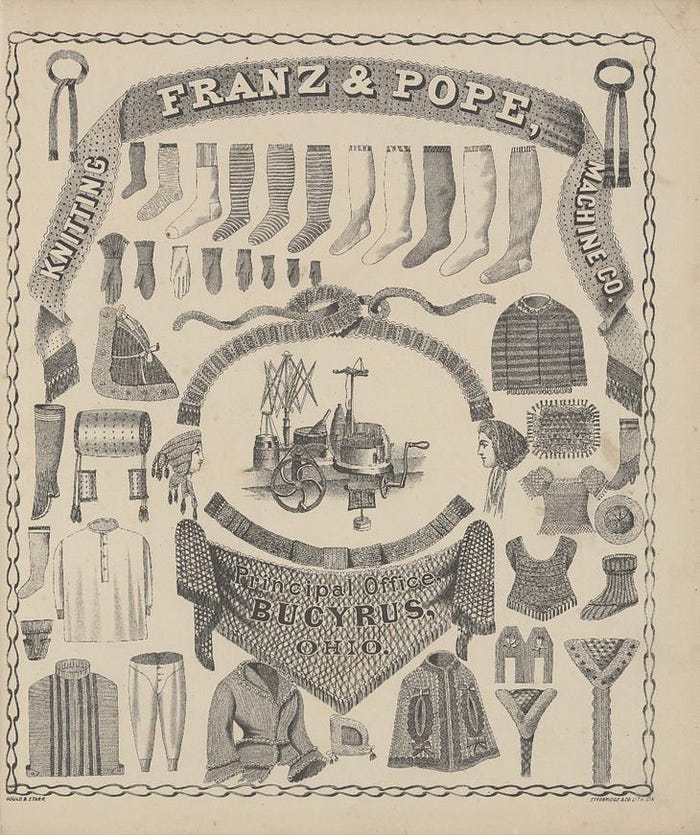By Thomas Palmer
Here on Galion History Corner we are taking a look at the life of a former Galionite whose name you have likely heard because of a clothing company he established over a century ago. The man’s name was Henry D. Lee.
The first chapter in the series can be read here.
Henry Lee’s early career began with a position as a night hotel clerk at the Riblet House on Public Square. 1
A clerk’s duties undoubtedly brought Henry into regular contact with a wide variety of people, not only guests from all over the country but also local businessmen who were potentially important contacts. As a clerk’s shift would end each morning, the influential men of the community would be arriving for breakfast and conversing in the hotel dining room, and Henry most likely overheard a great deal. He also shined their shoes for additional income.
Henry soon learned of an opportunity and took it. He had managed to save $2,000 by this point, likely helped by the Lees’ modest expenses living with his in-laws down the street. He approached Christian S. Crim, President of the First National Bank, and asked about a loan for $3,000, using the $2,000 as collateral. Crim agreed. 2
One source says that the loan was for real estate, but a very different purpose was also likely. He had become acquainted with the “get rich quick” idea of its day. Unlike usual outcomes with such schemes, however, the enterprising Lee succeeded.
The Franz & Pope Knitting Machine was to be his ticket to riches, he believed.
Knitting machines were all the rage in the 1860s and 1870s. They were made primarily for domestic use producing socks, but also gloves, mittens, shirts, jackets, scarves, and more. The Franz & Pope version was manufactured in nearby Bucyrus, with the original patent issued in 1869, the year of the Lees’ marriage.

Advertisements appeared by the company all over the country looking for salesmen. Henry sought the position of a general agent and an assigned territory in which to sell the device. 3
What happened over the next three or four years was remarkable. Lee was named agent for five states in the east. By 1871, at the age of just 22, he had opened a business office in the former home of Revolutionary War Colonel Thomas Hartley in downtown York, Pennsylvania, keeping an office in Galion as well. He brought on an associate, James P. Reisinger, who was the son of Galion’s first doctor, to staff the location in York. 4
Newspapers in York carried help wanted ads seeking on the road salesmen reading:
For the FRANZ & POPE KNITTING MACHINE, the latest and best invention of the kind, without any of the defects of earlier patents. A Sock knit heel and toe complete, without any hand finishing, in seven minutes. We also have a Knitting Room in connection with the office, where all kinds of knitting will be done to order.
Address H.D. LEE & CO., Office one door West P.O., York, Pa. 5
The company in Bucyrus was a bustling place situated along the railroad. In the hosiery department alone, thirty women were employed. In 1876, the latest version of the Franz & Pope Knitting Machine was exhibited at the Centennial Exposition in Philadelphia. 6 In attendance at the Exposition were Henry and Emma Lee.
Business was strong and Lee invested his proceeds into real estate. He dabbled for a bit in a bakery and a brokerage business as well. 7 By that time, however, Henry had moved on in his thinking. His next field was something entirely different. The oil business was really where a fortune could be made.
Footnotes:
1 Built as the two story structure in the early 1850s, the hotel was going through a substantial expansion project while Henry was working there. A third story was added and wings were built on the west, giving the building its current general appearance and footprint. The hotel was known as Riblet House and Western House during this period, but the Riblet House name remained attached until 1874 when it was first called the Central Hotel. The building, Henry D. Lee’s first place of employment, survives to this day and is the location for senior housing.
2 NRHP Form
3 The 1873 Crawford County Atlas included a full page advertisement for Franz & Pope. (see below).

4 York Daily, York Gazette — October 10, 1871. Lee rented the location, which was in operation for at least two years. When the business left, the building was almost immediately demolished by the owner, a local church. This was a loss of a local landmark still written about and mourned over a century later.
Reisinger’s father, Dr. John Reisinger, was an early settler in Galion and one of those who established Galion’s Reformed Church, now First United Church of Christ. Before his death, Reisinger built a house which still stands, though currently vacant, in the first block of South Boston Street.
5 York Gazette — October 31, 1871
6 The listing in the Official Catalog of the Exposition can be viewed here — see #354.
The Franz & Pope company had closed its doors in Bucyrus by 1900. Dr. Pope, the surviving founder, had passed away a few years before, hastening its demise.
7 Galion Inquirer — May 4, 1922.
Image by Van3ssa 🩺 Desiré 🙏 Dazzy 🎹 from Pixabay





